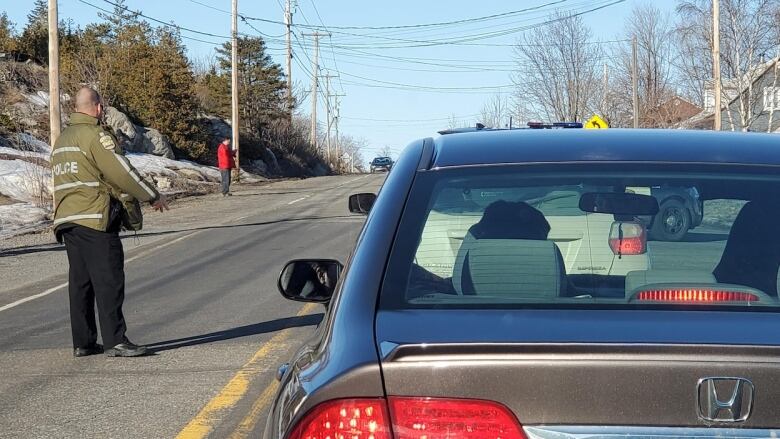Rural leaders urge Quebecers to be vigilant as travel restrictions are lifted
Government must act quickly to stem outbreaks if COVID-19 cases flare up where there are few now, they say

Municipal officials in rural regions of Quebec say they're counting on visitors to be cautious and on the Quebecgovernment to act quickly if COVID-19 cases start to flare up once travel restrictions within the province are lifted throughout the month of May.
On Wednesday, Deputy Premier Genevive Guilbault announced the province will be gradually scaling backits non-essential travelban in mostregions of the province.
Road blocks, fines and random police checks were put in place in late Marchin many regions, in an effort to limit travel andkeepthe virus from spreading outside larger cities like Montreal and Quebec City.
Guilbault said sincebusinesses and industries will be gradually reopeningin the coming weeks, it was the "logical next step" to allow people to travel.
Cottage country to open
The first regions to reopen, as of May 4, are theLaurentians, Lanaudire, Chaudire-Appalaches, and the area around Rouyn-Noranda.
The deputy mayor of Sainte-Agathe-des-Monts,Jean-Lo Legault, said the government's decision comes at the right time.
He said he is not "overly concerned" thatMontrealers who own cottages or secondary homes in the Laurentians are sure tobe driving up.
"Most of them are going to come up and have a look at their home for the weekend and go back," said Legault.
Even though the province is asking Quebecers to stay in their own regions and avoid "non-essential travel,"a spokesperson with Guilbault's office told CBC people are allowed to go to their secondary homes, although they should bring their groceries with them to avoid shopping locally.
Chris Winlo,co-owner of Mont-Tremblant Activities, an outdoor outfitter, said that "grey zone" is making it hard to anticipate how the new rules will impact business.
"I'm happy that it's reopening, but it doesn't mean that tourism will open for us orthat people will be able to come here unless it's considered essential," said Winlo.

He expects the government will answer some of those questions in the coming days. He countshimself lucky that the economic shutdown happened in the spring, the "in-between season" for Mont-Tremblant's tourism industry.
"The timing is good, but the result was still dramatic and drastic."
'Mixed reactions' from residents
The Chaudire-Appalaches region, on the south shore of Quebec City, has only392 confirmed cases of COVID-19. It has been closed off from its neighbours for several weeks a situation the mayor of Beaumont, David Christopher, said hasgone on long enough.
"We only have a small grocery store here and a small butcher shop," said Christopher. That'slimitedwhat residents could purchase, sincethey weren't allowed to drive to the city of Lvis, just 20 kilometres away.
During the summer, Beaumont's population of 3,000 grows by nearly 10 per cent with the arrival of summer residents in the town's three campgrounds. Many campers come from what are now COVID-19 "hot spots."
"That concerns me a little bit," said Christopher. "I think most people will stay home and won't come in, but that is going to be hard to control."
The reopening will be phased out gradually over the month of May.
The travel ban will be lifted in the Abitibi-Tmiscamingue, SaguenayLac-Saint-Jean, La Tuque and Outaouais (with the exception ofGatineau)on May 11.
On May 18, theLower Saint-Lawrence, Gasp, Magdalen IslandsNorth Shore and Charlevoixregion will follow suit.
The mayor of Gasp, Daniel Ct, said the government's announcement is getting "mixed reactions" from citizens.

"I'm not sure the population was ready for such a rapid reopening," Ct said. He expected travel to be lifted between regions where there were fewer cases, for example, between Gasp and the Lower Saint-Lawrence, "but not to the entire province."
Nonetheless, Ct said he was optimistic travelandeconomic activities will get back on track"slowly and progressively."
He is also waiting forclearer directives from the government to know what to expect for the summer tourism season. He hopes the Gasp's natural landscapes and open spaces will allow some businesses to operate.
"I'm sure we'll have some kind of tourism, but nothing like the 800,000 visitors we usually welcome every year."
Above all, Ct said, he will be keeping a close eye on the number of cases of COVID-19 in the Gasp region, currently sitting at 164 one of the lowest in the province.
"If reopening brings an escalation of the pandemic, we will ask the public health authorities to step back."
With files from Cathy Senay, Spencer Van Dyk and Victoria Emanuelle Forest-Briand













_(720p).jpg)


 OFFICIAL HD MUSIC VIDEO.jpg)
.jpg)



























































































